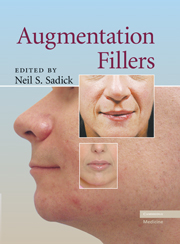Book contents
- Frontmatter
- Contents
- LIST OF CONTRIBUTORS
- Ch. 1 Application of Fillers
- Ch. 2 Approach to Choosing the Ideal Filler
- Ch. 3 Patient Selection, Counseling, and Informed Consent
- Ch. 4 Hyaluronic Acid Skin Derivatives
- Ch. 5 Collagen Products
- Ch. 6 Radiesse
- Ch. 7 ArteFill
- Ch. 8 Augmentation Fillers in Cosmetic Dermatology: Silicone
- Ch. 9 Advanta Expanded Polytetrafluoroethylene Implants
- Ch. 10 Sculptra
- Ch. 11 Lipo Transfer
- Ch. 12 BioAlcamid®
- Ch. 13 Combination of Approaches in Augmentation Fillers in Cosmetic Dermatology
- Ch. 14 Filling Complications
- Ch. 15 Postprocedure Management and Patient Instructions
- Ch. 16 Conclusion: Future Trends in Fillers
- INDEX
- References
Ch. 3 - Patient Selection, Counseling, and Informed Consent
Published online by Cambridge University Press: 26 February 2010
- Frontmatter
- Contents
- LIST OF CONTRIBUTORS
- Ch. 1 Application of Fillers
- Ch. 2 Approach to Choosing the Ideal Filler
- Ch. 3 Patient Selection, Counseling, and Informed Consent
- Ch. 4 Hyaluronic Acid Skin Derivatives
- Ch. 5 Collagen Products
- Ch. 6 Radiesse
- Ch. 7 ArteFill
- Ch. 8 Augmentation Fillers in Cosmetic Dermatology: Silicone
- Ch. 9 Advanta Expanded Polytetrafluoroethylene Implants
- Ch. 10 Sculptra
- Ch. 11 Lipo Transfer
- Ch. 12 BioAlcamid®
- Ch. 13 Combination of Approaches in Augmentation Fillers in Cosmetic Dermatology
- Ch. 14 Filling Complications
- Ch. 15 Postprocedure Management and Patient Instructions
- Ch. 16 Conclusion: Future Trends in Fillers
- INDEX
- References
Summary
INTRODUCTION
Dermal fillers have been available for more than 100 years, originally as injectable fat and more recently as biocompatible soft tissue fillers. The use of fillers has continued to increase in cosmetic surgery practices with the greater demands from patients for aesthetic improvement without surgery. This increase is secondary to not only the growing indications and availability of dermal fillers but also the desire for rejuvenation from a wider patient population among varying age groups and ethnicities. Currently available dermal fillers include porcine, bovine, and human collagens, hyaluronic acid (HA) preparations of animal or biosynthetic origin, poly-l-lactic acid products, polymethacrylate, and calcium hydroxyapatite. The use of soft tissue fillers is an attractive office procedure for providers because of the associated ease, cost, and minimal discomfort involved in treatment. Although the use of injectable soft tissue fillers is relatively safe, it is important to select patients carefully and counsel them appropriately to avoid complications. The process of informed consent is a crucial component of the relationship that must develop between the provider and the patient to minimize the already rare occurrence of legal complications.
PATIENT SELECTION
The media and manufacturer marketing has instilled views and expectations of complete rejuvenation of facial aging in patients by the use of fillers. Patient selection is important to have satisfied patients and reduce undesired outcomes. A thorough review of the history is the first step in this process.
- Type
- Chapter
- Information
- Augmentation Fillers , pp. 13 - 16Publisher: Cambridge University PressPrint publication year: 2010



